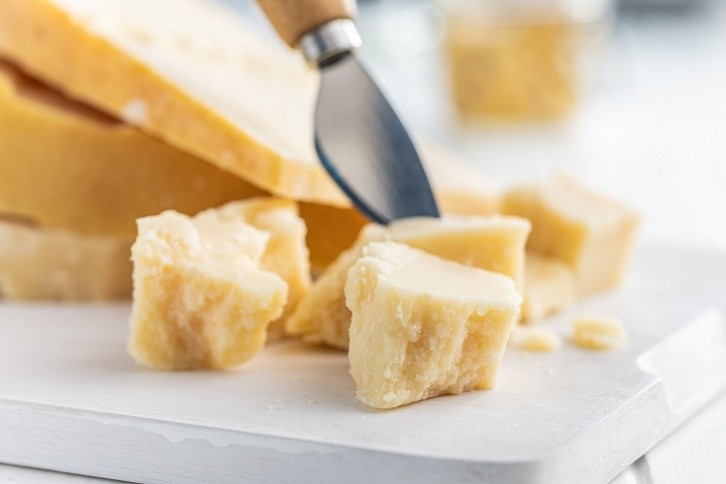PDO-protected cheeses rampant with diverse bacteria

The European Union’s Product Designation of Origin (PDO) scheme aims to protect the heritage of certain foods by regulating the method used to produce them. Some of the most iconic examples are champagne and Prosciutto di Parma.
Cheese has many PDOs, from Parmigiano Reggiano to Comté. Europe has a rich history of unique cheeses and these products must be produced, processed and prepared in the specific region in which they originate. France alone has 51 dairy products carrying the PDO seal.
All of these dairy products are influenced – in texture, in taste, and in rind formation – by bacteria, yeasts and moulds introduced by both the sources of milk used, and the fermentation process. These microbes will go on to enrich the intestinal microbiota of consumers of said cheeses.
Because of the radical regional diversity in PDO-protected cheeses, the microbiota of many of these dairy products is immensely varied. A new study published in the journal ISME Communications analysed more than 2000 microbiotas from PDO-protected French cheeses, collected from samples from 386 farmers and cheese producers across France and finding an abundance of diverse bacteria.
How varied are the microbiotas of PDO-protected cheeses?
The study analysed 2,702 rinds and cores of 44 French PDO-protected cheeses, along with detailed information about their production conditions in 2017.
The researchers found an extraordinarily diverse range of bacterial species, with 820 found in the cheese, and 1,230 bacterial species in the cheeses' milk sources.
The 10 most dominant bacterial species found were well-documented cheese colonisers. However, these species made up less than 50% of the cheese rind’s bacterial community, and less than 75% of the cheese core (except in the case of PLCF, or lactic bloomy rind, cheeses).
Some cheeses had more diversity than others. The most bacterially diverse cheese rind families were the soft bloomy rind cheeses, soft washed rind, hard cooked cheese, and uncooked pressed/semihard cheese. The cheese cores with the highest bacterial richness were soft washed rind and soft bloomy rind.
The bacterial and fungal population of the milk sources was more diverse, with less than 40% made up of the 12 dominant fungal and bacterial species.
Analysing the bacterial species, researchers found there was no core microbial species across the cheeses analysed (the threshold for this being that it must make up more than 0.1% of microbial species in a cheese and appear in 90-100% of the samples).
How does regional variation impact these microbiotas?
The concept of ‘terroir’, originally coined for wine, takes into account a cheese’s local ecological drivers, including the climate, soil and rainfall of its area of origin, and human activities such as processing.
The study hypothesised that, because PDOs are, by their very nature, specific to regions, and have highly diverse conditions, or ‘terroirs’, they are far more likely to have microbial diversity Whether ‘terroir’ is a relevant category in cheese has been a major point of contention in the scientific community, but the study set out to prove – or disprove – its importance.

The study found that the key driver of the microbiodiversity found in the cheeses were the milk species. However, the next most prominent were the region from which the cheese originated, and the topography of its origin.
At a farm level, the key variables were dairy breed, bedding type, grassland type and udder hygiene practices (for example, the lack of pre-milking udder cleaning in goats was a contributor). Bacterial communities were more affected by these factors than fungal communities.
PDO was found to be a significant differentiator of microbial differences. It explained 61.9% of variance for richness and 60.2% of variance for beta diversity for bacteria in the cheese core. In the rind, it explained 63.5% of variance for richness. Other key factor in its variability were the technological family used to make the cheese, and the production methods. PDO cheeses originating from different regions but belonging to the same cheese family do share some microbiological types.
Sourced From: ISME Communications
'A comprehensive, large-scale analysis of “terroir” cheese and milk microbiota reveals profiles strongly shaped by both geographical and human factors'
Published on: 11 July 2024
Doi: https://doi.org/10.1093/ismeco/ycae095
Authors: F. Irlinger, M. Mariadassou, E. Dugat-Bony, O. Rué, C. Neuvéglise, P. Renault, E. Rifa, S. Theil, V. Loux, C. Cruaud, F. Gavory, V. Barbe, R. Lasbleiz, F. Gaucheron, C. Spelle, C. Delbès























